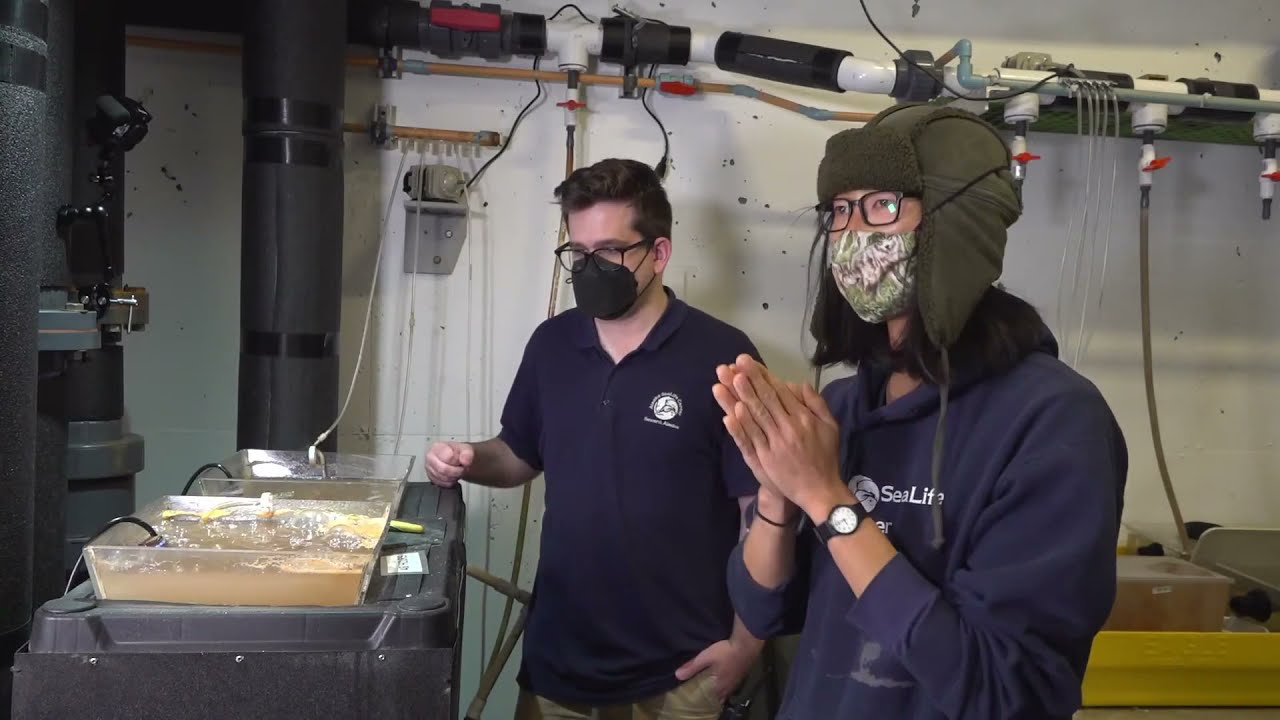*****
Summary of Transcript:
The video is a virtual visit to the Alaska Sea Life Center in Seward, Alaska, sponsored by the Royal Caribbean Group and Alaska Travel Industry Association Foundation. The video discusses microhabitats and the smallest animals the aquarium staff hatched and raised from eggs. They talk about the need for tiny food for tiny filter-feeding animals and show brine shrimp being harvested in a system of two cauldrons. They use a microscope to show viewers the eggs and larvae of the shrimp. The video also encourages viewers to ask questions and provides a text number for them to do so.
*****
Summary of Description:
The Alaska SeaLife Center offers a free virtual program every Wednesday at 11 AM for all ages, giving an inside look at the animals and staff at the center. One topic covered is the hatching of their tiniest animal, the brine shrimp, and the program includes an illustration of the brine shrimp life cycle and music by Kevin MacLeod. These virtual visits are made possible by generous support from the Royal Caribbean Group and Alaska Travel Industry Association Foundation.
*****
Learn How and Why We Hatch Our Tiniest Animal
If you’re looking for a great way to entertain and educate yourself and your family, the Alaska SeaLife Center’s Virtual Visits program is the perfect way to do it. Every Wednesday at 11 AM, you can join us for a FREE virtual program that takes a deep dive into the world of marine life. During these visits, you’ll get an inside look at the animals and staff that contribute every day to the mission of the Alaska SeaLife Center. In this Virtual Visit, we’ll explore the life cycle of one of our tiniest animals: the brine shrimp.
Introduction
The Alaska SeaLife Center is dedicated to conserving and protecting Alaska’s marine ecosystem. To accomplish this mission, we work with various marine animals, from otters to seals to fish. But one of our most interesting and important animals is the brine shrimp. These tiny creatures play an important role in the marine food chain, and we’re proud to have a program dedicated to hatching them.
Why Brine Shrimp
Brine shrimp are an important source of food for many marine animals. They’re small enough to be eaten by tiny specimens like larval fish, but they’re also a good source of nutrition for larger animals. But even though they’re small, brine shrimp are also fascinating creatures in their own right. Their unique life cycle involves transforming from tiny eggs to fully formed adults in just a few short weeks.
The Life Cycle of Brine Shrimp
The Alaska SeaLife Center has a unique program dedicated to hatching brine shrimp. To do this, we start with tiny eggs only about the size of a pinhead. We put these eggs into a special solution that mimics the conditions of the ocean, including temperature and salinity. Then, we wait. Over the next few weeks, the eggs will hatch into tiny larvae, feeding on the algae in the solution. As they grow, they’ll shed their skin several times, growing larger each time. Finally, the brine shrimp will fully form in adults after about three weeks. At this point, they’ll be large enough to be fed to our other animals, or we’ll release them back into the wild.
Conclusion
The life cycle of the brine shrimp is fascinating, and it’s just one of the many ways that the Alaska SeaLife Center is working to protect Alaska’s marine ecosystem. By hatching these tiny creatures, we’re helping to ensure that there’s always a healthy food supply for our larger animals. But we’re also learning more about these creatures through our research, which helps us better to understand the complexity of the marine food chain. So the next time you want something to do, join us for a Virtual Visit and learn more about the amazing animals at the Alaska SeaLife Center.
*****
Source Description
Learn how and why we hatch our tiniest animal.
Join us each Wednesday at 11 AM for a FREE virtual program for all ages.
Virtual Visits bring you an inside look at the animals and staff that contribute every day to the mission of the Alaska SeaLife Center. Whether you consider yourself an ASLC amateur or “a fish tornado,” there is always something to discover!
Virtual Visits are made possible by generous support from the Royal Caribbean Group and Alaska Travel Industry Association Foundation.
Credits:
“Brine Shrimp Life Cycle” illustration: Utah Division of Wildlife Resources
Link: https://wildlife.utah.gov/13-fishing.html?start=8
“Sea-Monkeys” ad scan: Roger Johnson, via Flickr
Link: https://flic.kr/p/8HUdDE
License: https://creativecommons.org/licenses/by-sa/2.0/
Sincerely by Kevin MacLeod
Link: https://incompetech.filmmusic.io/song/5033-sincerely
License: https://filmmusic.io/standard-license
Lobby Time by Kevin MacLeod
Link: https://incompetech.filmmusic.io/song/3986-lobby-time
License: https://filmmusic.io/standard-license
Bossa Antigua by Kevin MacLeod
Link: https://incompetech.filmmusic.io/song/3454-bossa-antigua
License: https://filmmusic.io/standard-license

